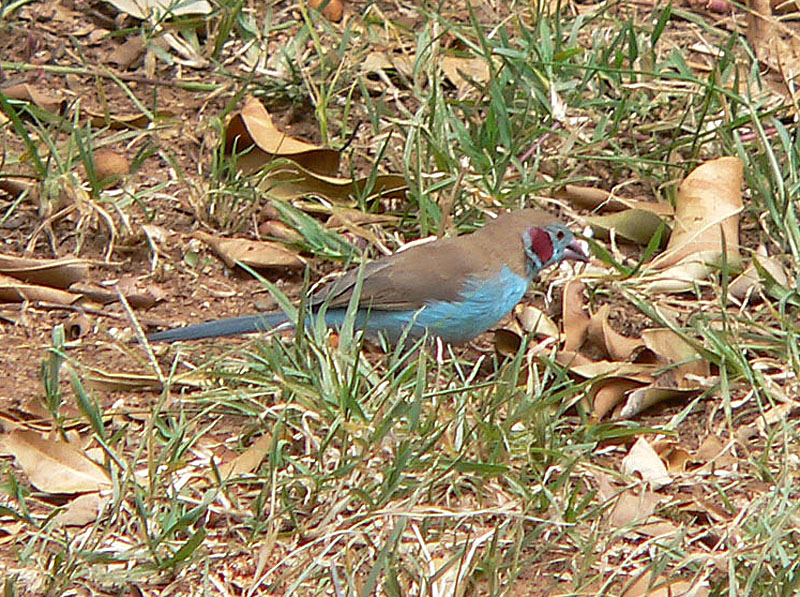An Under-handed Reproductive Strategy
At first glance, it might seem odd that East Africa’s pin-tailed whydah is such a popular aviary bird, as this resourceful sneak lays its eggs in the nests of other species, and relies upon the unwitting “foster parents” to raise its young. This reproductive strategy, termed brood parasitism, is shared by most the whydah’s 18 relatives, all classified within the family Viduidae. I should point out that adult whydahs do not (as is the case with a better known brood parasite, the common cuckoo, Cuculus canorus) toss out or eat the host’s eggs, and the fledglings rarely dislodge host chicks from the nest – the foster parents usually raise both successfully.So, in order to breed pin-tailed whydahs, one must have at least one mated pair of host birds, synchronized to lay eggs at a time favorable to a mated pair of whydahs. As successful and aspiring breeders can imagine, this can be very tricky, and will likely consume no small amount of time, space and money.
However, upon first viewing a male whydah in courtship flight, I immediately understood why many people happily put in the effort. The breeding male trails a fabulous, 10-12 inch tail from his 5-inch long, finch-like body, which itself is boldly marked in black and white. What’s more, his bobbing flight is often punctuated by falcon-like dives, which add to the drama of the display. Three to six females, or more, may line up to view his efforts.
Breeding Whydahs
Those of you with spacious outdoor aviaries, and tempted to take on a new challenge, might wish to consider this fascinating bird. Its usual host, the red-eared waxbill (Estrilida troglodytes) is common in the trade a reliable breeder. The waxbill’s courtship behavior usually brings the whydah into breeding readiness in short order.
If you do take on pin-tailed whydahs, bear in mind that they are polygamous in nature, and so are best kept in groups consisting of 1 cock and 2-6 hens (males are intolerant of each other). If you lack the space required by these gorgeous birds, by all means try to see them in a zoo or, better yet, in the wild (they are quite common throughout much of East Africa – the name “whydah” is drawn from a Nigerian town of the same name).
You can read more about whydahs in the wild and captivity at:
http://www.honoluluzoo.org/pintailed_whydah.htm
 That Bird Blog – Bird Care and History for Pet Birds
That Bird Blog – Bird Care and History for Pet Birds


 I was recently involved in designing an exhibit for sun conures, and was inspired once again to consider their suitability as pets and as birds for public exhibit. In their latter role, they are unparalleled – splashed in bright orange and yellow, and possessed of boundless energy, they never fail to delight zoo and aviary visitors. I furnished the exhibit mentioned with dead tree limbs and grapevine, and the new inhabitants lost no time in amusing themselves for hours on end.Pet conures, however, are often not so fortunate as those housed in public exhibits, since not everyone can deal with their loud voices and need for attention and exercise. People are often lured by the group’s spectacular plumage, and may not consider all that is involved in owning such a bird – they can be wonderful pets, but only in the right situations.
I was recently involved in designing an exhibit for sun conures, and was inspired once again to consider their suitability as pets and as birds for public exhibit. In their latter role, they are unparalleled – splashed in bright orange and yellow, and possessed of boundless energy, they never fail to delight zoo and aviary visitors. I furnished the exhibit mentioned with dead tree limbs and grapevine, and the new inhabitants lost no time in amusing themselves for hours on end.Pet conures, however, are often not so fortunate as those housed in public exhibits, since not everyone can deal with their loud voices and need for attention and exercise. People are often lured by the group’s spectacular plumage, and may not consider all that is involved in owning such a bird – they can be wonderful pets, but only in the right situations. Vocal tendencies aside, there can be no doubt that the sun conure makes a charming pet. In addition to its brilliant coloration, it is very playful and has a friendly, curious demeanor. The jenday conure, perhaps even more outgoing, is also a great companion bird – but is among the most vocal of the group.
Vocal tendencies aside, there can be no doubt that the sun conure makes a charming pet. In addition to its brilliant coloration, it is very playful and has a friendly, curious demeanor. The jenday conure, perhaps even more outgoing, is also a great companion bird – but is among the most vocal of the group.
 Budgerigars should be offered a mix of seed based (i.e.
Budgerigars should be offered a mix of seed based (i.e.